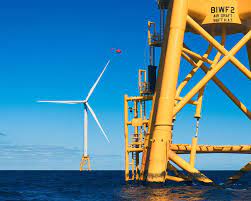.
Article by Elizabeth Kolbert, New Yorker Magazine, November 28, 2022
BIWF2 is a wind turbine that sticks up out of the Atlantic Ocean, about fifteen miles off the coast of Rhode Island. It’s six hundred feet tall, which is higher than the Washington Monument, and its blades are more than two hundred feet long. I’m on a boat designed to transport crews to offshore wind farms. The captain maneuvers right up to the metal stanchions that hold the turbine in place, so the blades are rotating directly overhead. They make a fantastic whooshing sound that builds and fades, builds and fades. The effect is at once thrilling and terrifying, as if some gigantic bird were trying to land on the deck. “Ah,” everyone on board exclaims as another blade descends.
BIWF2 has one neighbor half a nautical mile to the north and three more neighbors to the south. Together the turbines make up Block Island Wind Farm, America’s first offshore wind operation. A dozen more wind projects are currently planned off the East Coast, from Massachusetts to North Carolina.
The turbines that will be erected in these projects will make BIWF2 look puny. Staring up at the blades, I am looking into the future — or at least a future —and it’s inspiring. BIWF2 is a symbol of what can be accomplished when people put their minds to it.
In 1992, the year of the Earth Summit, the world had exactly one offshore wind farm, called Vindeby. Situated off the Danish island of Lolland, it consisted of eleven turbines, which, collectively, produced less power than BIWF2 does today. Now there are scores of offshore farms, most of them in European and Chinese waters. The largest, known as Hornsea 2, is in the North Sea, off the English coast; it comprises a hundred and sixty-five turbines, each so massive that a single sweep of its blades can power a household for a day.
Block Island Wind Farm and Hornsea 2 are owned by the same company, which used to be known as Danish Oil and Natural Gas, or dong, but recently— and for obvious reasons — changed its name, to Ørsted. (It also owned Vindeby, which was decommissioned in 2017.) As more turbines have gone up, costs have plunged; just in the past decade, the price of offshore wind energy has declined by half.
Onshore wind has grown even faster, and its cost, too, has plummeted. In many parts of the world, it’s now cheaper to put up turbines than it is to operate an existing power plant that burns natural gas. In places with a lot of wind, such as Denmark, Ireland, and western Oklahoma, there’s sometimes so much power pouring into the grid that producers have to pay to get rid of it.
The price of solar power, meanwhile, has declined even more spectacularly. Since 2010, it’s dropped by more than eighty per cent. According to the International Energy Agency, solar power now offers “some of the lowest-cost electricity ever seen.”
The rapidly falling price of renewables makes it possible to imagine a not too distant future in which the U.S., indeed the world, generates all its electricity emissions-free. Already there are brief periods — on the order of minutes —when California can produce enough electricity from renewables to meet its demand. In Denmark, this happens for entire windy days. (It occurred two days in a row this past May.)
And, once it’s possible to imagine a carbon-free grid, all sorts of other opportunities open up. Substitute electric motors for internal-combustion engines and cars, too, can run emissions-free. The same goes for trucks and buses, ferries and forklifts. Plug them in! Tear out boilers and replace them with heat pumps! Swap gas ranges for induction stoves! Electrify as much as possible. Ideally, electrify everything. (e!)

